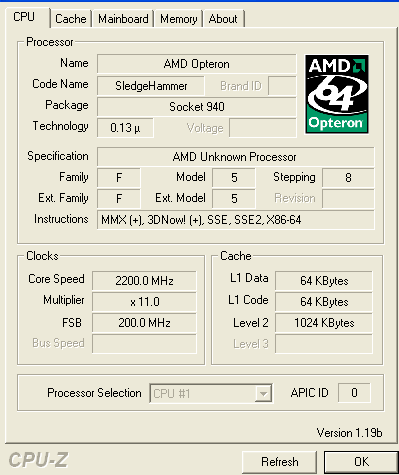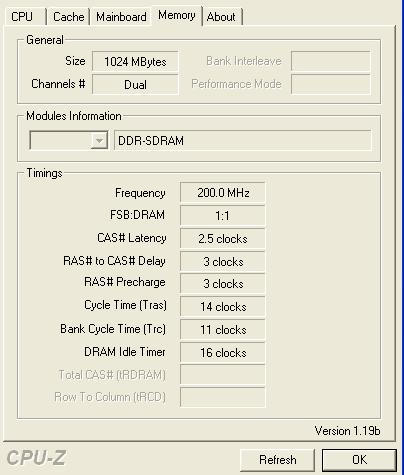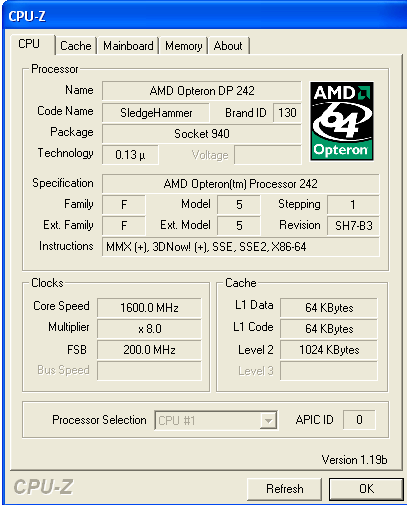Systems setups and notes
Here's a quick rundown of the test system should you wish to compare benchmark results with your own.
- AMD Athlon64 FX51 CPU (2.2GHz) RAM running with an 11 divisor (DDR400, dual channel)
- AMD Opteron 242 (1.6GHz) RAM running with an 8 divisor (DDR400, dual channel)
- Intel Pentium 4 3.2GHz ES 800FSB CPU
- AMD Barton XP3200+ S462 CPU (2200MHz / 200FSB)
Other components
- ATi Radeon 9
Software
- Windows XP Professional
Notes
The FX51 runs at the same clock speed as a standard XP3200+ Barton. However, with a number of core enhancements that will pay immediate dividends in 32-bit applications, we expect it to be comfortably faster than its stablemate. If AMD had stuck to its PR ratings, the FX51 would lie somewhere between XP3400+ and XP3600+, such is the efficiency of the new K8-series. AMD's True Performance Initiative purports to help consumers understand that there's more to overall performance than pure MHz; something that consumers are not that willing to accept currently, it seems.
The FX51 sits on top of a brand-new NVIDIA nForce3 Pro150 motherboard, with this particular sample coming from ASUS. We're concentrating on the CPU for this review, so the motherboard will be reviewed individually and in detail. Suffice to say that it supports 940-pin CPUs, be they named Opteron or FX. It supports your standard 8x AGP graphics cards, a single Opteron 1xx / 2xx / FX CPU, Hypertransport link at up to 600MHz, affording 2.4GB/s in each direction, and a reasonable South Bridge that omits some of the more tasty features found in the current nForce2 South Bridge. What's more, our sample shipped with the ability to run the Legacy Electronics ECC RAM at DDR400 speeds, giving a potential 6.4GB/s of bandwidth. Note that there's also a 754-pin single memory channel 32/64-bit CPU that's obviously not compatible. As the FX51 protects the L1 data cache, it only uses registered / ECC DIMMs. This'll be the point that most enthusiasts will abhor. Registered PC3200 DIMMs are expensive and in short supply currently. AMD kindly provided us with 1GByte of Legacy Electronics DDR400 ECC RAM for this review. OCZ has now announced that it'll produce and distribute compliant memory in the very new future, but let's be frank about this, your expensive Corsair XMS4000 TwinX unbuffered memory will not work; trust us, we've tried.
As the on-chip DDR controller uses 2 64-bit channels, memory must be installed in pairs. Getting matched pairs of memory is now important than ever before. Whilst the other comparison combinations are running super low latency timings, the FX51 / nForce3 setup, due to the relaxed Legacy Electronics ECC RAM, is running stability timings.


CPU-Z 1.19b isn't exactly sure what it is. Is it an AMD64, Opteron, FX, something else ?. This is where confusion will arise, undoubtedly.


Here's the comparison Opteron 242, running at 1.6GHz. The 242 has a single coherent link that allows it to be used in multiprocessor systems, but the differences, bar the clock speed deficit, finish about there. Memory speed is a divisor of CPU or on-board memory controller's speed. The motherboard allows one to define approximate speeds to the various PCxxxx standards. For example, if you wish to run the FX51 with DDR333 memory, one must take into account a suitable divisor of 2200MHz that will most closely sit, but not cross, DDR333 speeds. 2200/14 is the closest ratio we can come up with.

The ASUS board seems to agree. Setting a divisor of 13 would have given a memory speed of 169.2MHz (DDR338.4), which is a little quicker than the required specification. We'll list some of the more prominent characteristics below.
| CPU | AMD Athlon64 FX51 | XP3200+ Barton | Pentium 4 3.2GHz |
| Clock speed | 2200MHz | 2200MHz | 3200MHz |
| L1 cache | 128kb | 128kb | 20kb |
| L2 cache | 1024kb | 512kb | 512kb |
| Memory bandwidth | 6.4GB/s (nForce3 Pro150) | 6.4GB/s (nForce2) | 6.4GB/s (i875P) |
| FSB | 2200MHz (core speed) | 400MHz | 800MHz |
| Integer pipeline length | 12 | 10 | 20 |
| CPU Die Size | 193mm² | 101mm² | 131mm² |
| Transistor count | 105.9 million | 54 million | 55 million |
| Manufacturing process | 0.13-mircon SOI | 0.13-micron | 0.13-micron |
| OS Support | 32/64-bit | 32-bit | 32-bit |
| Voltage | 1.55v | 1.65v | 1.525 - 1.55v |
| Pin count | 940 | 462 | 478 |
It's packed with transistors that push up the overall die size to 193mm². That means it won't be cheap to manufacture.
Our benchmarks will currently address the FX51's ability with 32-bit programs. We expect a number of enthusiasts to adopt the FX-series as cutting-edge performance hardware, irrespective of its ECC necessity. 64-bit OS's are thin on the ground and drivers are a current problem. We'll have another look at its 64-bit performance once we obtain a finalised OS and complete driver set. The FX51 shipped in a PC built by AMD, but the trial 64-bit Microsoft XP OS refused to boot correctly, which is a shame.
Jus to summarise before we begin benchmarking, the Athlon64 FX51, running at 2.2GHz and using 2 x 512 registered PC3200 DIMMs with slack latencies, will be run up against the equivalently clocked XP3200+ on a slick nForce2 Ultra 400 board and a Pentium 4 3.2GHz Northwood CPU on top of a tweaked ABIT IC7-MAX3. An Opteron 242, running at 1.6GHz will also provide a valid comparison to the 2.2GHz FX51, as they're essentially similar CPUs. A 2.4GHz 800FSB Pentium 4, running on a tweaked DFI Springdale, will provide further midrange comparisons.
We'll be running our usual benchmarking suite for this first test. Once we test the ASUS SK8N in full, we'll add a number of workstation-orientated benchmarks. It will be interesting to see how it comes out against the impressive VIA K8T800 940-pin motherboards.









